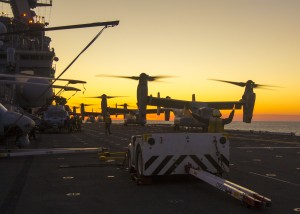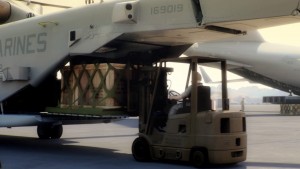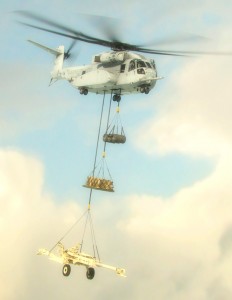The Role of the CH-53K in the Evolution of the MAGTF
The MAGTF and the USN-USMC team are working on shaping a 21st century approach to joint operations from the sea.
There is a broader transformation of jointness being shaped by the evolution of the amphibious forces has escaped attention as precisely what it is – the transformation of joint capabilities.
In broad terms, amphibious operations has shifted from primarily providing a transport capability to providing a base of operations for the air-land-sea domains, and the flexibility of the evolving amphibious task force allows it to focus on the primary domain necessary for the mission: ground, air or sea.
It is a flexible Swiss army knife for joint operations.
The V-22 Osprey has been a key agent of change whereby ground forces can be inserted at greater distance, resupply can be managed from land to the sea base, or force packages built around the Osprey can execute missions previously only possible with the “large deck” amphibious ships.
There is little question that there is a significant shortage of L-class ships and the enablers for what the evolving amphibious task force needs, but it is also clear that allies are looking at Navy-Marine Corps innovation and seeing the future of a key joint capability.
Whether it be South Korea, Japan or Australia, in the Pacific the core U.S. allies see the amphibious force as part of their joint force transformation as well.
The Osprey and the F-35B are clearly shaping such a transformation.
The Osprey with its range and speed has changed the operational approach of the amphibious ready group. With the coming of the F-35B to the amphibious fleet an organic C2, ISR, EW and strike asset will integrate with the fleet and provide for a wider range of effects from the sea-based force.
In an interview last year with the head of the 2nd Expeditionary Strike Group (Admiral Cindy Thebaud) and with Capt. Michael M. McMillan, Commander of Amphibious Squadron Eight who had just returned from command of the Iwo Jima Amphibious Ready Group off of the waters of Yemen, the evolving flexibility of the amphibious group was highlighted and discussed in detail.
With the impact of the Osprey and now the coming of the F-35B, the amphibious task force is much more than a transportation asset, and as such, joint operation capabilities need to be forged, shaped and transformed going forward.

With the refocusing efforts in tandem with platforms like the Osprey and F-35B, the Navy is shifting from a strictly transport force from point A to B to becoming an expeditionary tactical strike and power projection asset as part of the national security equation.
When I asked her about that, Thebaud acknowledged that she sees such an evolution as having an impact on the evolution of the Navy overall.
“We already have 80% of the ships and other major equipment we’ll have 20 years from now. The key is to evolve its capability and to draw upon the new systems to shape a more effective combat force,” she said.
The evolution of amphibious capabilities will allow the rest of the surface fleet, and the aircraft carriers to evolve as well.
An important aspect of the joint capability, which a dynamically evolving and integrated Navy-Marine Corps capability brings to the fight, is to support what we have called force insertion….
Capt McMillan’s recent operational experience provided many examples of the evolving capabilities of the Amphibious Ready Group and challenges to be met in enhancing its capability to deliver joint effect. As McMillan put it, “We felt that what we did during the operation was unique, but I think that over time, our ‘unique and unusual’ will become the norm.”
He added, “Put another way, our unique joint capabilities as a Navy-Marine Corps force can be mixed or matched to deal with a variety of tasks in the battlespace, and that flexibility is probably becoming the norm as a requirement, and we are looking to enhance that flexibility going forward.”
The CH-53K as a 21st century air system will add significant capability to the evolution of the amphibious fleet as well, given its capacity for much more efficient heavy lift, which can be delivered to multiple points in the battlespace, faster, and with significantly enhanced integration with the other combat assets.
The aircraft will be able to externally carry nearly three times the current load of the E and offload with much greater flexibility, safety and security.
Given its significantly improved readiness and reliability, greater sortie rates will be generated, coupled with independent triple hook capability, managing logistical throughput will significantly reduce ship to the shore transit time.
Just how the capabilities of the new aircraft intersected with the evolving operational approaches was discussed with three key Marines involved in the program we started by focusing upon the maintainability and sustainability aspects of the new air system.
The three Marines were as follows: Col. Paul Fortunato, Branch Head, Weapons Requirements (APW-1); Col. Hank Vanderborght, Program Manager, PMA-261/H-53 Heavy Lift Helicopters; and Major Thomas Trimble, Heavy Lift Requirements (APW-51), Department of Aviation, USMC.
Question: Let us start with the materials technologies which make this very different from an E. Composites are now a norm for new air systems, as opposed to when the E was conceived of and built. How do the material technologies affect the K?
Answer: By leveraging modern engineering practices and materials, we have enhanced performance. The structural strength of the aircraft provides for extra performance, and is clearly a key reason why the K can lift nearly three times more than the E externally in the same ambient conditions.
It is obvious but important to underscore that a heavy lift mission is just that; and leads to stresses and strains on the aircraft, and the airframe. The plane has been designed to take the stress of a three time enhanced lift capability and we are testing the aircraft rigorously and robustly to ensure that the performance is being met.
Question: The avionics and the fly by wire system are a major shift as well from the E to the K. How will the new technology have an operational impact from your perspective?
Answer: We land in hostile and in degraded visual environments.
The new systems will have a number of increased capability impacts, one of the most significant is stable hover.
Because of the ability of the aircraft to hover assisted by technologies onboard, we can land the aircraft much more safely and in difficult degraded visual environments.
Automation will assist is in managing the flight and let us focus much more on the mission.
There are two different flight control modes on the aircraft, PFCS and AFCS.
During different missions, one can select different flight control modes that are optimized for those missions.
The different fly by wire systems actually assist the pilot in optimizing those systems for the assigned mission.

Question: What about the cockpit and the situational awareness of the pilot and the flight crew?
Answer: The cockpit is a glass cockpit with five Multi-Functional Displays.
They dramatically increase air crew situational awareness.
The fly-by-wire flight control system makes the aircraft a lot easier to fly and allows the crew to focus on what the MFDs can provide to shape mission effectiveness.
Safety and security are significantly enhanced.
We have had mishaps with the E because of low visibility and brownouts.
If I could compare, the 53K comes in to pick up an external load, there is a flight director in the aircraft, almost like an airliner.
And when you fly at the initial point, which is the last checkpoint on your route before the landing zone to pick up the external, the 53K pilot can push a button and the aircraft will fly itself to the load and basically come into a steady hover at a preselected altitude right over the load.
For example, if the pilot wanted that aircraft to go to 20 feet over the load, he would put those parameters in the system and hit the button and the plane will do that.
With regard to what we call “divided attention,” where you need to multi-task, the systems help you manage that as well.
For example, say you were inbound to a landing zone and you are about to come pick up an external load. And all of a sudden you get a call on the radio that says, hey, change your mission. You now need to pick up the external and go to a different location and drop it off.
Because the aircraft is so augmented and is able to do pretty much the pilots’ job, the crew can start re-planning that mission while one pilot can monitor the aircraft and the other pilot can actually re-plan the mission to go to the new landing zone.
Whereas in the Echo, it took the entire attention of the entire crew just to stay safe to pick up that external load in a difficult environment.
The power of the fly-by-wire system combined with the displays inside the aircraft makes the K much safer than other military helicopters.
Question: Clearly, the K is core logistical asset.
How is it a next generation aircraft from the logistical point of view, beyond its significantly improved maintainability?
Answer: The K has two key features, which make it a next generation aircraft.
The first is the widening of the cabin to allow it to load Air Force 463L pallets.
Currently, when the Air Force arrives with a C-17 or C-5, we have to crack open the 463L pallets and re-palletize them into 48 x 48 wooden pallets and then put them into the CH-53E.
With the K we will be able to take them directly off of the C-5 or C-17 and roll the pallets right onto the Kilo and go to whatever FOB we need to deliver the cargo to. This optimized intra-theather lift and logistical throughout will be much greater.
The second is the triple hook system which no other helicopter has. Whereas the E can only do a single and dual point, the Kilo can do a single, dual and triple point.
The beauty of this capability is that we can be on an L-Class ship and pick up three independent loads. And then in one sortie, drop off those loads at three independent locations which from a logistical point of view give you much greater flexibility than we have ever had before.
The Echo was built in a former era when you brought supplies as part of a support wave; the K is being built in the age of force insertion across a distributed battlefield.
You can support three different company landing teams across the battlefield that could be supported by one ship, with three loads taken from the ship and then going to zone one, zone two and zone three without ever having to back to the ship to reload.
This saves not only transit time but exposure to threats while flying the aircraft among multiple loadings rather than loading a triple package and taking off for the area of interest. You save sortie numbers simply by being able to use the triple hook system.
Put in simple terms, the K will contribute to optimizing your capabilities for maneuver warfare.

Question: The K is a marinized helicopter as well.
While we are at it, could we discuss the differences between an Army helicopter landing on a ship and a marinized helicopter landing on a ship, before the strategic community gets carried away with the notion that the Army can transfer its air assets to ships?
Answer: That is a good point. There are significant differences here.
The first is simply the point about electronic systems; the ship has to turn off many of its systems to allow Army helos to land on ships.
Electromagnetic hardening of the aircraft is crucial so that the electronic components in the aircraft can be protected from radars and other ship-board electronic systems, when it operates aboard naval shipping.
This is especially critical if you are operating a fly-by-wire system.
Comment: I guess you want to keep your fly-by-wire system and not turn it into a fry-by-wire system!
Answer: The second is simply ability to operate with large wind envelopes at sea because extensive testing is done.
If you take an Army helicopter to a ship you can only land on a ship if you basically have five knots of wind using a generic helicopter wind envelope.
The ship has to adjust its heading to accommodate the tight wind envelope that it may or may not be able to get allowing the helo to land.
With a marinized aircraft, we can land with large wind speed and direction envelopes.
The ship will minimize maneuvering in order to get the winds within those envelopes for the aircraft to land.
Testing is conducted to maximize those wind envelopes within safe operating conditions.
The other issue of course is corrosion.
At sea you always have salty sea spray and mist.
If your helo is not marinized against corrosion, material condition and operational reliability will suffer.
Our aircraft is designed, built, and tested with this in mind.
Question: What ships will the K be able to land on?
Answer: The same ships that the E can land on.
The CH-53K’s maximum weight on wheels is only 5,000 pounds more than the Echo but it is able fold down to a smaller shipboard footprint.
Question: Let us go back to the question of lift and beyond the question of new materials technologies, how is the K able to lift nearly three times more than an E externally?
The video above shows the first flight of the CH-53K seen at the West Palm test facility on September 28, 2015.
Answer: While expanding capability, engineers were challenged not to exceed the current logistics footprint of the current CH-53E.
There are three technologies which come together to create this capability.
The new engines (T-408-GE-400) provides the lifting power.
The split torque gearbox generates the power to the blades from the engine.
The new rotor blades with anhedral tips.
The K’s rotor blades are much more efficient than those of the Echo.
They are all composite and the new materials allowing for developing and building a more efficient blade.
Question: I know that Germany among other allies is considering the K as an addition to their force. And currently, the competition seems to be between the Chinook and the K. How would you compare them?
Answer: It is basically 1960s technology versus 21st century technology with the implications for capabilities, maintainability and flexibility being weighed heavily favor of the K.
The mission is one of lift; and there is no comparison between the two helos.
The max gross weight on the K is 88,000 pounds; the Chinook is 50,000 pounds, they are not even in the same rotorcraft weight classification.
You get to the area of interest faster, safer and with the flexibility of deploying in support of multiple FOBs given the three hook system.
This article was first published on March 10, 2016.

